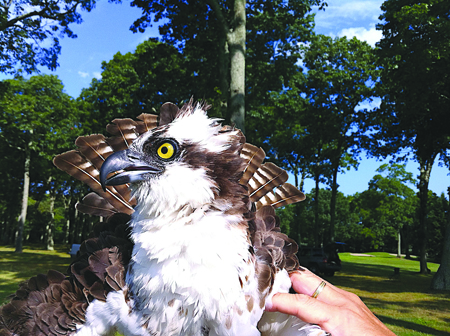Tracking one osprey’s winter voyage to Venezuela

The osprey’s journey from the brink of extinction to being a commonplace sight once more on the North Fork has been well-documented. Few people, however, have the chance to witness the bird’s annual journey from local shores to the heart of South America.
Rob Bierregaard, an ornithologist at the University of North Carolina, has been tracking the flight paths of New England ospreys for about 10 years, but this summer he tagged his first North Fork bird.
Dubbed North Fork Bob, the bird was tagged in early August behind the fifth hole of the North Fork Country Club in Cutchogue. So far he has made one of the most dramatic pilgrimages of the 10 birds that Mr. Bierregaard has tracked this season.
Mr. Bierregaard thinks Bob is 4 to 5 years old. He left Cutchogue on Sept. 19, and has made steady southward progress ever since, while four other birds Mr. Bierregaard tracked this season were caught up in Caribbean hurricanes and may have perished.
On Sept. 19, Bob left his summer home at about 9:30 a.m. and flew due west for 9 hours, stopping in northwestern New Jersey for a night’s roost. By the following evening, he was in North Carolina. It took him six days after that to reach the Florida everglades, and scientists believe he spent his mornings during that week fishing and waiting for thermals to develop before taking off.
Leaving Florida he made a leisurely 10-day jaunt across Cuba, Haiti and the Dominican Republic and then spent two days island-hopping across the Caribbean and one day on an atoll 20 miles from the Venezuelan coast, sitting out nasty weather that appears to have caused the death of one other tagged bird that didn’t wait it out.
Signals from three other birds also disappeared during the migration at times and places affected by bad weather, but North Fork Bob has been making his way slowly into the Venezuelan Amazon basin.
Mr. Bierregaard said that North Fork Bob has stopped several times where thought the bird’s nesting areas would likely be. After a few days at each site, Bob moved on again.
“He knows where he’s going,” he said. “Almost all of them reach South America … some go all the way to Argentina.”
North Fork Bob probably knows the terrain very well. After ospreys are born in North America in the spring, they fly south during their first autumn, spending an average of 18 months as juveniles in the warmer climate, building up strength to make their way north to breed. They return to the same area every winter.
Mattituck resident Bob Sheehan, an attorney who met Mr. Bierregaard on a golf outing in Ireland, is the man to credit for the tagging of North Fork Bob.
He sponsored Bob’s transmitter and the data downloads of his trip, which cost about $6,000 for the 18-month research project.
“I’ve always been interested in birds, and I’ve always been intrigued by the story of them coming back from brink of extinction due to DDT,” said Mr. Sheehan.
Mr. Sheehan helped to tag North Fork Bob on that morning back in August. The researchers placed an osprey nest on the golf course and put a whole sea bass in it. Pieces of fishing line with slipknots were hidden in rubberized chicken wire. The knots tightened around the osprey’s talons when he came in for the prey, trapping him. Researchers put a hood over Bob’s head and took him down to be measured, tagged and released.
“I was holding him. They’re quite calm when they have the hood on. It looks like they’re a pet,” said Mr. Sheehan. “You can feel their heart beating against the back of your palm. His heart was beating pretty fast.”
The booby-trapped nest was not North Fork Bob’s regular nest, but one he decided to raid when he saw the fresh fish sitting unattended. Signals from his transmitter showed that he repeatedly returned to a cell phone tower on Elijah’s Lane north of Route 25. Osprey enthusiast Tim Perry, who photographed North Fork Bob’s tagging, interviewed workers in a building near the tower who said that ospreys had been nesting there for the past two years, but that the nest had been removed by the tower’s owners this past spring.
“They didn’t know they’re not supposed to do that,” said Mr. Bierregaard of the owners. “The way he hung around that cell tower tells me he’s attached to it. Rebuilding [a nest] isn’t any big deal. The ospreys get sort of used to that. I’m sure he’ll be heading back there.” But first, North Fork Bob needs to find a place to spend his Amazon summer while the North Fork is in the depths of a winter freeze.
More information on Bob’s travels can be found online at http://www.bioweb.uncc.edu/bierregaard/maps%202010/Bob-2010.htm.
[email protected]


